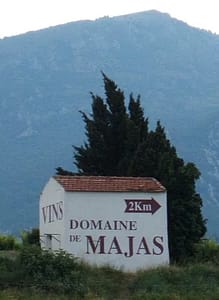Domaine de Majas is run by Alain and Agnes Carrère. The 30 hectare domain is located in the Roussillon by the village Caudiès de Fenouillèdes. Tom Lubbe from nearby Domaine Matassa helped to change into organic cultivation. The vineyards are at 350-400 meters’ height in slopes with good exposure and drenage. We see around 120 year old vines of carignan, grenache noir and macabeu, and younger (30-35 years) of syrah, cabernet franc, merlot, rolle and chardonnay. The climate is affected by the nearness of the Pyrenees and the Mediterranean sea.
The wines are fermented with natural yeasts in old cement tanks, some steel and a small percentage old, used wood.
Here we experience harsh winters and warm, sunny summers. The tough northwestern wind from the Pyrenees and the wet Mediterranean breeze often follow each other.
Even if the domain lies within the AOC Côtes du Roussillon they often choose to classify their wines as Vin de Pays de Côtes Catalanes, to honour what they consider te be a unique area.
The soil is mainly chalky clay and schist.
The grapes for this wine are grenache 50%, grenache gris 25%, and grenache blanc 25%. They were hand-harvested, naturally fermented in cement and aged there for 6 months.
Cortado 2017 (Dom. de Majas)
Light ruby. Aroma of white flowers, plums, peach and raspberry. In the mouth it’s intense, fruity with round tannins.
Price: Low
Food: Light meat, white fish, salads




